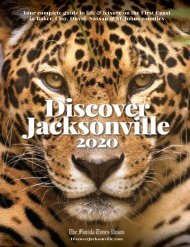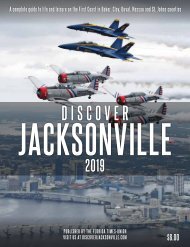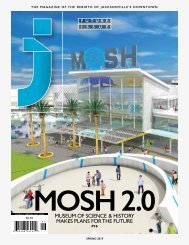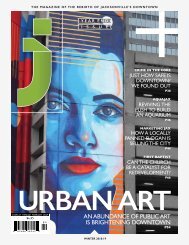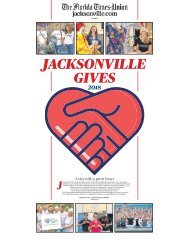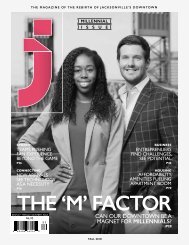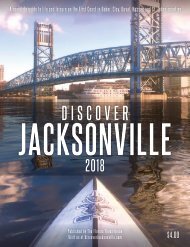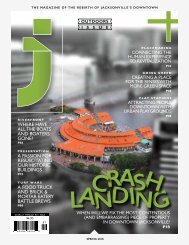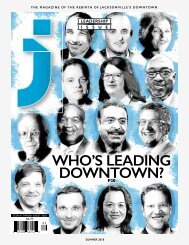J Magazine Winter 2019
Create successful ePaper yourself
Turn your PDF publications into a flip-book with our unique Google optimized e-Paper software.
{ }<br />
“The way I look at it, we’re living in that same type<br />
of transformative time frame, where we went from<br />
a horse and buggy to the horseless carriage ...<br />
but the changes are happening much faster now.”<br />
– NAT FORD –<br />
Bay across from the sports complex. Other companies<br />
are coming in to participate, and state and federal transit<br />
officials are following JTA’s research and testing.<br />
“I’m sitting back here and saying, is this the next Uber<br />
that’s happening?” Ford said. “That’s where we are as the JTA.<br />
We’re not on the bleeding edge of technology, but as we make<br />
our decisions, we are recognizing that transportation is transforming,<br />
technology is advancing. Artificial intelligence is advancing.<br />
Electrification is advancing. So as we are making our infrastructure<br />
decisions now or planning decisions now, we incorporate that in.”<br />
The technological innovation doesn’t stop with the U2C. It will be<br />
part of the Bay Street Innovation Corridor, a smart-cities project that<br />
will embed technology along Bay from the sports complex to the JRTC,<br />
providing a constant stream of real-time data to ease traffic flow.<br />
Take the people to transit<br />
Now that, hopefully, you’ve gotten your head around U2C, what<br />
might be next on Ford’s plate is TOD, which stands for transit-oriented<br />
development. That idea is to take public transit to the places<br />
where people want to, and likely will, live and actually facilitate the<br />
housing development — rather than have transit later chase the development<br />
in a catch-up.<br />
Right now, JTA is trying to sell or lease five “lazy” parcels around<br />
Downtown, with more parcels to come when the Rosa Parks Transit<br />
Station on West Union Street moves to the JRTC. The way Ford sees<br />
TOD: “If we increase this density and increase residents Downtown,<br />
we will at some point be charging fares on the U2C, so we<br />
pick up the fare revenue, and our system becomes more efficient<br />
and effective because of people riding it … and we are priming the<br />
pump for more density and more ridership and fare revenue.”<br />
Ford says developers already are watching what JTA does and<br />
considering that in their plans. “On First Coast Flyer routes, if you<br />
look in within a quarter-mile of each one of those lines, you’d be<br />
surprised that the level of development or permits that are being<br />
pulled and anticipated already on the east line, the north line and<br />
the southeast, but on the (upcoming) southwest line, we are actually<br />
already seeing where people are kind of handicapping the development<br />
that will occur along our BRT lines.”<br />
Taking transit to the people<br />
Ford’s technology ambitions go beyond Downtown. As part of<br />
what it calls its Agile Plan, JTA already has talked about deploying autonomous<br />
vehicles with Jacksonville University and FSCJ and plans<br />
to approach the Mayo Clinic and maybe even St. Johns Town Center.<br />
“The idea is, one, there is a transportation need,” Ford said, “but<br />
two, that would continue with our learnings as it relates to these vehicles<br />
and how they operate in pedestrian environments and in different<br />
environments where AV technology deployment may make sense,<br />
because eventually in the long run you’re looking at the JTA having a<br />
fleet of autonomous vehicles.”<br />
While the U2C ultimately would extend through Brooklyn and on<br />
to Riverside, the demand is already there. Brooklyn alone has more<br />
than 1,000 new apartments built, under construction or credibly<br />
planned, but accessing the Skyway requires hiking over to LaVilla<br />
across the Park Street viaduct.<br />
But wait! Remember that large control center and maintenance<br />
facility is in Brooklyn. Ford has his staff looking at opening a Skyway<br />
station at that facility so Brooklynites could hop on the monorail for a<br />
free ride to the Central Station and connect to the rest of the system.<br />
“A quick immediate step,” he said. “What would it take? We have<br />
the maintenance leads (rails) that are used to bring the vehicles out<br />
in the morning and back in the evening. Is there a possibility that<br />
those leads can be leveraged in the interim? Just to provide that<br />
connectivity?”<br />
The ultimate vision<br />
If you think those plans and ideas are pretty radical for a city that<br />
is pretty much defined by the automobile, Ford has some perspective<br />
for you:<br />
“I think at one point, it might have been defined by horse and<br />
buggy, and then the automobile showed up. The way I look at it,<br />
we’re living in that same type of transformative time frame, where<br />
we went from a horse and buggy to the horseless carriage. Did you<br />
know, at some point, automobiles had to have a flag person actually<br />
walking in front of them with a little sign that it was coming? There’s<br />
going to be a change similar to the transformation that occurred<br />
then, but the changes are happening much faster now.<br />
“We need to embrace these new modes. We need to embrace<br />
our customers’ demands. Our customers are looking for door-todoor.<br />
When we talk about the U2C and autonomous vehicles expanded<br />
to 10 miles, the sky’s the limit, because we can at some<br />
point start talking about door-to-door service, where we actually<br />
pick you up at your door and get you on the main line and take you<br />
where you need to go. We’re looking at 24-hour service.<br />
“If we’re now looking at operation that has less manpower requirements<br />
in terms of operators, you’re talking about a service that<br />
is much more cost-efficient, so I could provide many more vehicles<br />
at a lower cost.<br />
“And so we’re just trying to be visionary and try to embrace the<br />
technology we know is coming.”<br />
FRANK DENTON is retired and the former editor of<br />
The Florida Times-Union and J magazine. He lives in Riverside.<br />
28<br />
J MAGAZINE | WINTER <strong>2019</strong>



